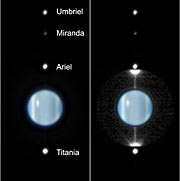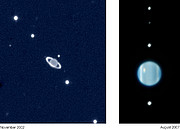Comunicato Stampa
Edge-On!
Peering at Uranus's Rings as they Swing Edge-on to Earth for the First Time Since their Discovery in 1977
23 Agosto 2007

As Uranus coasts through a brief window of time when its rings are edge-on to Earth - a view of the planet we get only once every 42 years - astronomers peering at the rings with ESO's Very Large Telescope and other space or ground-based telescopes are getting an unprecedented view of the fine dust in the system, free from the glare of the bright rocky rings. They may even find a new moon or two.
"ESO's VLT took data at the precise moment when the rings were edge-on to Earth," said Imke de Pater, of University of California, Berkeley who coordinated the worldwide campaign. She worked with two team members observing in Chile: Daphne Stam of the Technical University Delft in the Netherlands and Markus Hartung of ESO.
The observations were done with NACO, one of the adaptive optics instruments installed at the VLT. With adaptive optics, it is possible to obtain images almost free from the blurring effect of the atmosphere. It is as if the 8.2-m telescope were observing from space.
Observations were also done with the Keck telescope in Hawaii, the Hubble Space Telescope, and at the Palomar Observatory.
"Using different telescopes around the world allows us to observe as much of the changes during the ring-plane crossing as possible: when Uranus sets as seen from the VLT, it can still be observed by the Keck," emphasised Stam.
Uranus orbits the Sun in 84 years. Twice during a Uranian year, the rings appear edge-on to Earth for a brief period. The rings were discovered in 1977, so this is the first time for a Uranus ring-crossing to be observed from Earth.
The advantage of observations at a ring-plane crossing is that it becomes possible to look at the rings from the shadowed or dark side. From that vantage point, the normally bright outer rings grow fainter because their centimetre- to metre-sized rocks obscure one another, while the dim inner rings get brighter as their material merges into a thin band along the line of sight.
Two little satellites called Cordelia and Ophelia straddle the brightest ring, the 'Epsilon Ring', and keep it in place, but it has always been assumed there must be more of these satellites that are confining the 9 other narrow rings. Normally the satellites are lost in the glare of the rings, but during these events the unique orientation makes the bright rings essentially invisible. Thus the ring plane crossing gives astronomers a rare chance, just once every 42 years, to image these tiny satellites.
Imke de Pater and colleagues made observations of the rings with the Keck II telescope on 28 May 2007. These observations are presented in an article appearing today (Thursday 23 August) in Science Express, the online edition of Science magazine. There, the astronomers report that the rings of micron-sized dust have changed significantly since the Voyager 2 spacecraft photographed the Uranus system 21 years ago. Imke de Pater will discuss these results and the new images during a talk today at the European Planetary Science Congress 2007 meeting in Potsdam, Germany.
Note
Earth's orbit around the Sun permits three opportunities to view the rings edge-on during each ring-plane crossing: Uranus made its first ring crossing as seen from Earth on May 3, it made its second crossing on Aug. 16, and will cross for the third time on Feb 20, 2008. Though the last ring crossing relative to Earth will be hidden behind the Sun, most of Earth's premier telescopes, including the VLT, Keck, Hubble, and Palomar, plan to focus on the planet again in the days following December 7, 2007. December 7 is the Uranian equinox, when the rings are perfectly edge-on to the Sun, and after that there is a brief period again when one will view the dark side of the rings, before they become illuminated again for another 42 years.
Contatti
Imke de Pater
University of California
Berkeley, USA
E-mail: imke@berkeley.edu
Daphne Stam
Technical University Delft
Delft, Netherlands
Tel.: +31 30 253 5722
E-mail: D.M.Stam@sron.nl
Markus Hartung
ESO
Chile
E-mail: mhartung@eso.org
Sul Comunicato Stampa
| Comunicato Stampa N": | eso0737 |
| Legacy ID: | PR 37/07 |
| Nome: | Uranus |
| Tipo: | Solar System : Planet : Satellite Solar System : Planet : Ring |
| Facility: | Very Large Telescope |
| Instruments: | NACO |
Our use of Cookies
We use cookies that are essential for accessing our websites and using our services. We also use cookies to analyse, measure and improve our websites’ performance, to enable content sharing via social media and to display media content hosted on third-party platforms.
ESO Cookies Policy
The European Organisation for Astronomical Research in the Southern Hemisphere (ESO) is the pre-eminent intergovernmental science and technology organisation in astronomy. It carries out an ambitious programme focused on the design, construction and operation of powerful ground-based observing facilities for astronomy.
This Cookies Policy is intended to provide clarity by outlining the cookies used on the ESO public websites, their functions, the options you have for controlling them, and the ways you can contact us for additional details.
What are cookies?
Cookies are small pieces of data stored on your device by websites you visit. They serve various purposes, such as remembering login credentials and preferences and enhance your browsing experience.
Categories of cookies we use
Essential cookies (always active): These cookies are strictly necessary for the proper functioning of our website. Without these cookies, the website cannot operate correctly, and certain services, such as logging in or accessing secure areas, may not be available; because they are essential for the website’s operation, they cannot be disabled.
Functional Cookies: These cookies enhance your browsing experience by enabling additional features and personalization, such as remembering your preferences and settings. While not strictly necessary for the website to function, they improve usability and convenience; these cookies are only placed if you provide your consent.
Analytics cookies: These cookies collect information about how visitors interact with our website, such as which pages are visited most often and how users navigate the site. This data helps us improve website performance, optimize content, and enhance the user experience; these cookies are only placed if you provide your consent. We use the following analytics cookies.
Matomo Cookies:
This website uses Matomo (formerly Piwik), an open source software which enables the statistical analysis of website visits. Matomo uses cookies (text files) which are saved on your computer and which allow us to analyze how you use our website. The website user information generated by the cookies will only be saved on the servers of our IT Department. We use this information to analyze www.eso.org visits and to prepare reports on website activities. These data will not be disclosed to third parties.
On behalf of ESO, Matomo will use this information for the purpose of evaluating your use of the website, compiling reports on website activity and providing other services relating to website activity and internet usage.
Matomo cookies settings:
Additional Third-party cookies on ESO websites: some of our pages display content from external providers, e.g. YouTube.
Such third-party services are outside of ESO control and may, at any time, change their terms of service, use of cookies, etc.
YouTube: Some videos on the ESO website are embedded from ESO’s official YouTube channel. We have enabled YouTube’s privacy-enhanced mode, meaning that no cookies are set unless the user actively clicks on the video to play it. Additionally, in this mode, YouTube does not store any personally identifiable cookie data for embedded video playbacks. For more details, please refer to YouTube’s embedding videos information page.
Cookies can also be classified based on the following elements.
Regarding the domain, there are:
- First-party cookies, set by the website you are currently visiting. They are stored by the same domain that you are browsing and are used to enhance your experience on that site;
- Third-party cookies, set by a domain other than the one you are currently visiting.
As for their duration, cookies can be:
- Browser-session cookies, which are deleted when the user closes the browser;
- Stored cookies, which stay on the user's device for a predetermined period of time.
How to manage cookies
Cookie settings: You can modify your cookie choices for the ESO webpages at any time by clicking on the link Cookie settings at the bottom of any page.
In your browser: If you wish to delete cookies or instruct your browser to delete or block cookies by default, please visit the help pages of your browser:
Please be aware that if you delete or decline cookies, certain functionalities of our website may be not be available and your browsing experience may be affected.
You can set most browsers to prevent any cookies being placed on your device, but you may then have to manually adjust some preferences every time you visit a site/page. And some services and functionalities may not work properly at all (e.g. profile logging-in, shop check out).
Updates to the ESO Cookies Policy
The ESO Cookies Policy may be subject to future updates, which will be made available on this page.
Additional information
For any queries related to cookies, please contact: pdprATesoDOTorg.
As ESO public webpages are managed by our Department of Communication, your questions will be dealt with the support of the said Department.

